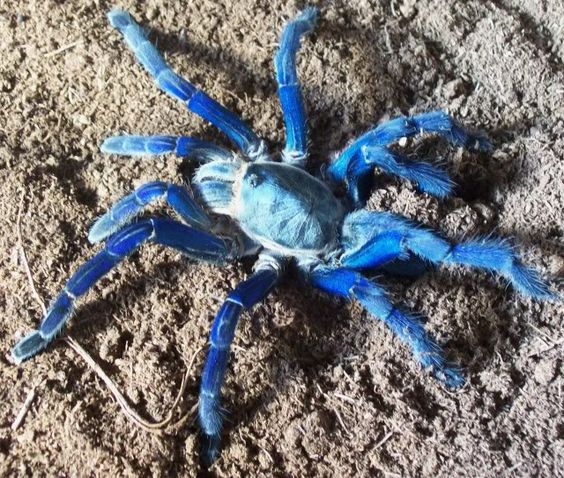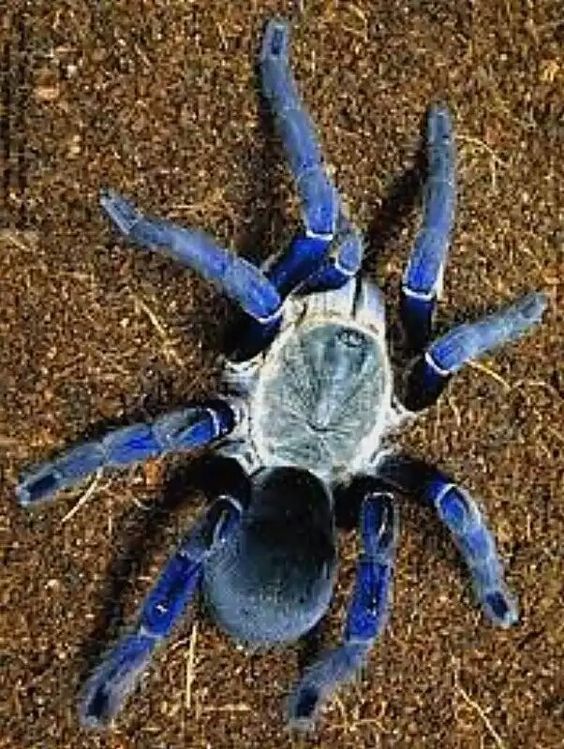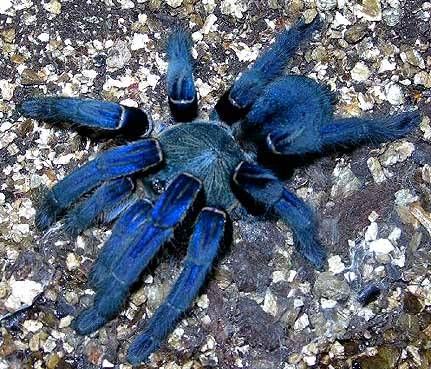Cobalt Blue Tarantula commonly called Haplopelma lividum are termed the rarest and most fascinating species among the 800 species of Tarantula that belong to the Theraphosidae family of spiders. Blue Cobalt Tarantula is an amazing species indigenous to parts of South Asia countries like Thailand, Myanmar, and Vietnam.
Cobalt Blue Tarantula can be a compelling pet, but having them as a pet is not easy. It isn’t the pet that will love cuddles or show a perfect visual display. They are for professional pet keepers who are trained and responsible enough to take proper care of the necessities of these spiders. You wouldn’t see Blue Cobalt Tarantula often as they are terrestrial species and like to live in the burrows underground in the dark.
Overview
| Common Name | Cobalt blue tarantula |
| Scientific Name | Cyriopagopus lividum |
| Family Name | Theraphosidae |
| Life span | Average 15 years |
| Size | The leg span of 13 cm |
| Nutrition | Insects like crickets and cockroaches |
| Tank Size | A tank of 10 to 20 Gallon |
| Price | Between $90 to $150 |
| Humidity | Humidity between 70 to 80 percent |
| Temperature | Temperature between 75 to 85 F |
Distribution
The Cobalt Blue Tarantula is a stunning species found in South East Asia. Mostly they are native to countries like Malaysia, Singapore, Myanmar, and over the border in Thailand.
Appearance & Size
Cobalt Blue Tarantula size extends to a leg pan of 13 cm. The name Cobalt Blue is due to its most fascinating feature of having dazzling blue legs. Their body and abdomen appear grey-blue and dull as compared to their legs. The blue color can be only seen in bright light otherwise the body appears black or dark grey. When the blue comes out it gives a glittery shiny hue off their hairs.
Natural Habitat
Terrestrial animals, Cobalt Blue Tarantula habitat is native to the borders of Thailand and Myanmar. They are the obligate burrowers who love to live under the ground in burrows. They only come out of their burrows in the search of food.

Life Span
The Cobalt Blue Tarantulas are medium-sized but they have a rapidly growing rate, Molting once or twice a year.
Like other Cobalt blue tarantula lifespan, a female tarantula can live an average life of 20 to 25 years while males have an average lifespan of 10 to 20 years because they die once they achieve maturity.
Temperament
The Cobalt Blue Tarantulas are temperamentally very aggressive and hence are termed as the aggressive species. They are triggered to attack in case of any danger and are defensive in nature. They don’t hesitate to attack anyone and anything in case of any harm or danger.
Their position changes when they are ready to attack, they tramp on the ground and raise their hands. They have a very strong bite that injects a little amount of venom into the victim. These are the indications of their aggressive and defensive nature. Because of their aggressive and swift nature, it is suggested that they are only kept by hobbyists and collectors.
Care Guide
The Cobalt Blue Tarantula lives in a tropical rain forest under the earth in burrow only come out and leave their lairs to scavenge for food. So if you are planning to have a tarantula as a pet you have to manage an environment similar to their natural habitat of warm and humid conditions with enough substrate to burrow for them.
Blue Cobalt Tarantulas although are medium-sized but grow rapidly and once they mature males and females are easily distinguished. Females become blue and males become blue-gray.
Feeding & Nutrition
The Cobalt Blue tarantulas are carnivores that eat their food by catching them on their own. They are impressive and fast predators that catch their unlucky prey from the edges of their burrows. They inject the venom in their prey paralyzed them and bring them inside the burrow and eat them alive.
Different Types of Food
Amphibians, insects like cockroaches, crickets, mice, and other spiders are the different types of food eaten up by the Cobalt blue spiders. They are called greedy because of their eating habits. They need a continuous food supply to grow rapidly. Their food must be fresh and alive not dead and frozen. They need fresh fuel for their rapid growth. They can eat 5 fresh crickets in a week.
Don’t feed your Cobalt Blue Tarantula cockroaches and crickets you find in your yard. Always feed them from pet food suppliers to ensure that it doesn’t contain any parasites and mites. Always ensure to remove leftovers.

Molting
The Blue Cobalt Tarantulas observe the process of molting once or twice a year. Molting is a process by which they shed their exoskeleton and regenerate their appendages. The process of molting is quite difficult for the tarantulas as they feel exhausted and roll onto the substrate over their back. Don’t touch them and try to handle them during this time. This process takes 15 minutes to several hours and tarantula takes time to recover from the irritation of this process.
Reproduction
When the male Cobalt Blue Tarantula reaches the stage of sexual maturity and is ready to reproduce it stores sperm in a silk sac and invites a female for mating by performing a tapping ritual by vibrating its body. If the female is receptive it comes out to take the male in the burrow where mating occurs. After mating, the female lays her egg inside the burrow.
Male’s Role
The male Cobalt Blue Tarantula injects its sperm into the female pedipalps and successful mating occurs. After the process of fertilization if the female doesn’t find the male satisfactory mating fellow it becomes the dinner of that female tarantula.
Female’s Role
After fertilization, the female lays eggs in the burrows about 100 to 1000 eggs which hatch after 45 days to 2 months. The female stays in the burrows with eggs until they hatch and build a web, especially for the young ones. After hatching the young ones stay with their mother for a week before entering their own world.
Health Concern
The most common and important health concern related to the Blue Cobalt Tarantula is that these tarantulas need to keep hydrated in captivity. They are often suspected of dehydration so they need proper hydration, humidity, and moist substrate.
The tank needs to be cleaned at least once a month. If the tank will not clean properly it will develop bacteria in the substrate from uneaten food. If the leftover remains in the tank the parasite and mites will infect Tarantulas and they become susceptible to many diseases.
Facts for Handling and Upkeep
- The Cobalt Blue Tarantula is a medium-sized animal with an average leg span of 5 inches. They need plenty of ground space in the tank for the burrowing and building web for catching their food.18″ x 12″ x 12″ tank is most appropriate for them.
- As the Blue Cobalt Tarantulas love to burrow you need plenty of substrate in the tank. The tank must have 6 to 8 inches of substrate that will be enough for the tarantulas to create burrows. A blend of cork, coconut coir, soil, and moss is a good substrate for the tank.
- The Cobalt Blue Tarantulas are experts in escaping and are termed as good escape artists. Make sure that the tank’s lid will be completely closed and tight and placed at a height so that they can’t escape and hide in the house.
- Blue Cobalt Tarantula are terrestrial animals native to the tropical rainforest. They need a humid environment to survive. The level of humidity in the tank should be 70 to 80 percent which will create a suitable environment for the Tarantulas to survive. Use a humidifier near the cage to keep the environment moist inside the tank.
- You can keep your Cobalt blue tarantula at room temperature. You don’t need any heating equipment for heating purposes. You only need them if you are living in a cold climate area to stabilize the cold temperature. The temperature should be between 75 to 85 F.
- The Cobalt Blue Tarantulas are aggressive and can attack in response to any threat. They are also very fast in escaping from the tank so it is suggested to be handled by professional pet keepers and hobbyists only.
- The tank of tarantulas should be cleaned properly any kind of leftovers and uneaten food should be removed from the tank otherwise they can cause bacteria and moss to develop and will cause diseases to the tarantulas. Don’t use your hands. You should use tongs for this purpose.
Keeping Cobalt Blue Tarantula Safe
The most important thing you need to do to keep them safe is to understand each aspect of the animal before having them as your pet. These are the animals that need proper care and nutrition to survive so it is suggested to learn about the animal before having them in your home.
You need to provide a perfect environment similar to their natural habitat with enough humidity, temperature, and substrate in the tank that is essential for them to survive. Keep the lid of the tank tight so that they can’t escape and keep them away from other pets and animals.
They are not that kind of animal to be handed or being cuddled so if you are trying to handle them make sure you are an expert and understand how to handle them but don’t force them to be handled.
Cobalt Blue Tarantulas a Threat to Humans?
The Cobalt Blue Tarantulas are defensive in nature that’s why they attack anything if they feel any threat in their defense. But their bite doesn’t cause any harm to the humans. There is no case of death and severe injury of humans after being bitten by the Tarantula.
Cobalt Blue Tarantula Venom
Although the bite of the Tarantula is very painful it doesn’t cause any harm to humans. The venom only kills the prey and helps them catch their food. If any human is allergic to venom they can seek medical assistance.
What Happens if a Tarantula Bites You?
The bite of Cobalt Blue Tarantula is very painful but it doesn’t cause any danger. Their bite feels like a bee sting and causes redness and itchiness at the site of the bite. Their bite is safe from any big danger which makes them a safe pet to have.
Indication of Attack
Whenever a Cobalt Blue Tarantula is about to attack it will change its position. It will stomp the ground and raise their legs which is an indication to step back. It will only attack if it feels any threat. Sometimes they don’t give any indication and attack. This is due to their wild and aggressive nature.
Legality
Having Cobalt Blue Tarantula as a pet is legal in most of the states and countries but there are some restrictions imposed on their breeding and captivity. To check whether it is legal to have them as a pet in your area check your local laws and regulations.
Safety Measures
Before cleaning the cage of the spider make sure your hands will be covered with a thick pair of gloves. It is better to use tongs to clean the cage. Don’t let the spider come near your face.
Where to Get a Tarantula & its Cost
You can find a tarantula from any pet shop but it is better to get it from a professional breeder to have a healthy tarantula. Freshly caught Tarantula is not suitable to obtain as a pet. It costs between $50 and $100 but there are many other things you have to buy so keep them all in your budget.
- The things are following which you need to buy:
- 10 to 20-gallon tank costs $25 to $50
- Substrate or dirt costs $5 to $10
- Heating Lamps costs $10 to $15
- Food costs $5 to $10 per week
- Water dish costs $5
- All you need is an initial budget of $135 and around $40 per month for food and substrate. A heating lamp is only needed in the winter season to maintain room temperature. At 75 to 85 F.
Conclusion
Although Cobalt Blue Tarantula is a stunning pet but everyone can’t handle it. They can only be kept by the expert pet keeper and hobbyist who knows every aspect of this animal and can handle them with great care.
Blue Cobalt Tarantula need an environment similar to their natural moist and humid habitat otherwise it becomes very difficult for them to survive. Proper humidity to prevent dehydration and substrate to burrow is essential for them.
Cobalt Blue Tarantulas are aggressive in nature and attack in case of any danger but they are not a threat to humans. They don’t love cuddles and to be handled frequently and very fast escaper so keep them properly in the tank and close the lid tightly.
Also, Cobalt Blue Tarantula doesn’t eat dead and frozen prey. They need fresh and alive prey to eat. You have to remove the leftovers and uneaten food to prevent bacteria to grow and keep them safe from all kinds of diseases.








